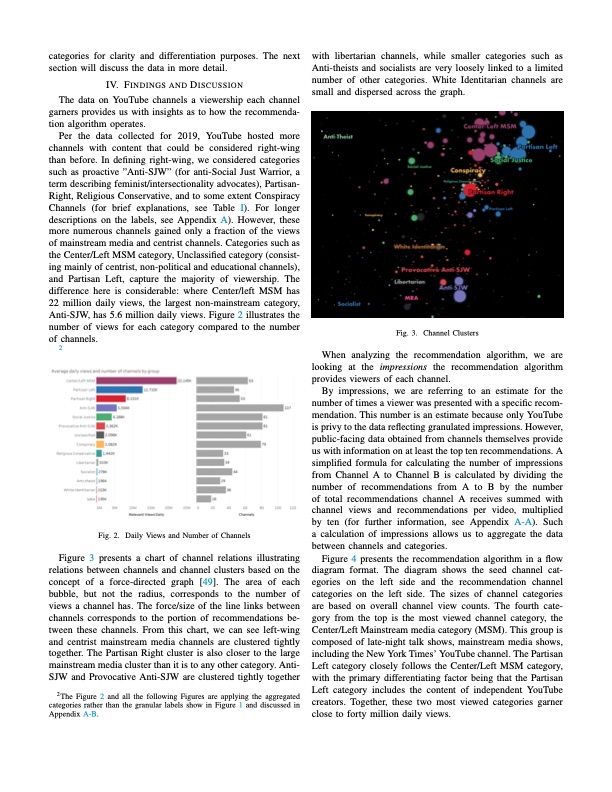
PDF Publication Title:
Text from PDF Page: 006
categories for clarity and differentiation purposes. The next section will discuss the data in more detail. IV. FINDINGS AND DISCUSSION The data on YouTube channels a viewership each channel garners provides us with insights as to how the recommenda- tion algorithm operates. Per the data collected for 2019, YouTube hosted more channels with content that could be considered right-wing than before. In defining right-wing, we considered categories such as proactive ”Anti-SJW” (for anti-Social Just Warrior, a term describing feminist/intersectionality advocates), Partisan- Right, Religious Conservative, and to some extent Conspiracy Channels (for brief explanations, see Table I). For longer descriptions on the labels, see Appendix A). However, these more numerous channels gained only a fraction of the views of mainstream media and centrist channels. Categories such as the Center/Left MSM category, Unclassified category (consist- ing mainly of centrist, non-political and educational channels), and Partisan Left, capture the majority of viewership. The difference here is considerable: where Center/left MSM has 22 million daily views, the largest non-mainstream category, Anti-SJW, has 5.6 million daily views. Figure 2 illustrates the number of views for each category compared to the number of channels. 2 Fig. 2. Daily Views and Number of Channels Figure 3 presents a chart of channel relations illustrating relations between channels and channel clusters based on the concept of a force-directed graph [49]. The area of each bubble, but not the radius, corresponds to the number of views a channel has. The force/size of the line links between channels corresponds to the portion of recommendations be- tween these channels. From this chart, we can see left-wing and centrist mainstream media channels are clustered tightly together. The Partisan Right cluster is also closer to the large mainstream media cluster than it is to any other category. Anti- SJW and Provocative Anti-SJW are clustered tightly together 2The Figure 2 and all the following Figures are applying the aggregated categories rather than the granular labels show in Figure 1 and discussed in Appendix A-B. with libertarian channels, while smaller categories such as Anti-theists and socialists are very loosely linked to a limited number of other categories. White Identitarian channels are small and dispersed across the graph. Fig. 3. Channel Clusters When analyzing the recommendation algorithm, we are looking at the impressions the recommendation algorithm provides viewers of each channel. By impressions, we are referring to an estimate for the number of times a viewer was presented with a specific recom- mendation. This number is an estimate because only YouTube is privy to the data reflecting granulated impressions. However, public-facing data obtained from channels themselves provide us with information on at least the top ten recommendations. A simplified formula for calculating the number of impressions from Channel A to Channel B is calculated by dividing the number of recommendations from A to B by the number of total recommendations channel A receives summed with channel views and recommendations per video, multiplied by ten (for further information, see Appendix A-A). Such a calculation of impressions allows us to aggregate the data between channels and categories. Figure 4 presents the recommendation algorithm in a flow diagram format. The diagram shows the seed channel cat- egories on the left side and the recommendation channel categories on the left side. The sizes of channel categories are based on overall channel view counts. The fourth cate- gory from the top is the most viewed channel category, the Center/Left Mainstream media category (MSM). This group is composed of late-night talk shows, mainstream media shows, including the New York Times’ YouTube channel. The Partisan Left category closely follows the Center/Left MSM category, with the primary differentiating factor being that the Partisan Left category includes the content of independent YouTube creators. Together, these two most viewed categories garner close to forty million daily views.PDF Image | Algorithmic Extremism: Examining YouTube’s Rabbit Hole of Radicalization

PDF Search Title:
Algorithmic Extremism: Examining YouTube’s Rabbit Hole of RadicalizationOriginal File Name Searched:
1912-11211.pdfDIY PDF Search: Google It | Yahoo | Bing
Cruise Ship Reviews | Luxury Resort | Jet | Yacht | and Travel Tech More Info
Cruising Review Topics and Articles More Info
Software based on Filemaker for the travel industry More Info
The Burgenstock Resort: Reviews on CruisingReview website... More Info
Resort Reviews: World Class resorts... More Info
The Riffelalp Resort: Reviews on CruisingReview website... More Info
| CONTACT TEL: 608-238-6001 Email: greg@cruisingreview.com | RSS | AMP |